To learn about split AC units or split air conditioners as room air conditioners. With rising global temperatures and disparity in the seasons, air conditioners have become more of a necessity than a luxury today! Since there’s a broad range of options available in the market to buy from selecting the perfect air conditioning unit for your home can be quite difficult.
MechStudies with this blog will help you to come out from the confusion and guide you to select the right as well as the best split air conditioner for your home. A few split AC models have been referred at the end if you want to buy. Let’s explore the basics of Split AC units or Split air conditioners as the best room air conditioners as well as a guide to select for home!
Split AC Units or Split Air Conditioners as Room Air Conditioners
Room Air Conditioners or Split AC units Basics
Before going to learn about the split AC units or split air conditioners system, first, we will see the basics. An AC, also known as an air conditioner, is a mechanical device that allows you to regulate the temperature of your room by extracting heat and dehumidifying it.
- Room air conditioners, as the name suggests, means the air conditioner which is used to condition a room, basically, it is used for domestic purpose, with low capacity.
- You simply need to set a temperature, whether it is higher or lower than the actual temperature outside your home, and after a while, you will have the exact level of warmth or coolness inside your room.
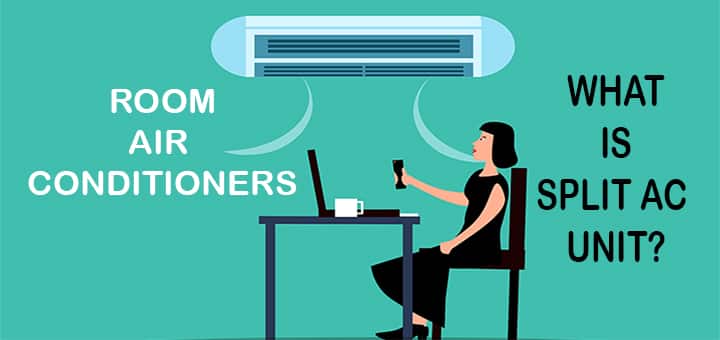
This is the simple basics of any air conditioner as well as split air conditioners.
History of Air Conditioners
Let’s get a rough idea about the history of air conditioners.
- The first person to plan a system to cool the rooms and lower the temperature was Dr. John Gorrie. In the 1830s, he patented a tool used to cool emergency rooms in hospitals, but it was more of an ice-maker than an air conditioning unit.
- The first cooling device was created in 1902, when an American inventor, Willis Carrier, created equipment for treating air.
- Living styles gradually changed, with industrialization and technical development environmental temperature raised exponentially, thus the need for conditioning systems also increased.
Parts of Split Air Conditioner Units
Let’s see a brief description about all parts,
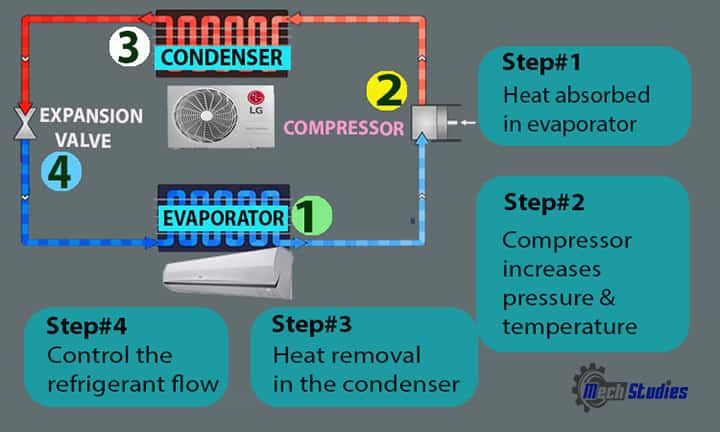
01. Evaporator in Split AC
An evaporator is essentially a heat exchanger coil that collects heat from the interior of a room using a refrigerating gas. The liquid refrigerant absorbs heat and evaporates into a gas in the evaporator.
absorbs heat and evaporates into a gas in the evaporator.
02. Compressor in Split Ait Conditioner
The expanded gaseous refrigerant is compressed in the condenser before sending it to the condensing unit. The compressor is located in the outdoor unit of the air conditioning system.
03. Condenser in Split Ait Conditioners
AC condenser is the outdoor part of the split air conditioning system which releases or collects the heat depending on the functioning it’s performing. The refrigerant is cooled into a warm liquid at the condenser and then passed through a conduit into the evaporator coil, where it extends and cools.
04. Expansion valve in Split AC
Also known as a throttle valve, an expansion valve is located between the cooling coil of the evaporator and the hot coils of the condenser. The amount of refrigerants used in the cooling and heating process is controlled by the expansion valve.
How Does Room Air Conditioners Work?
We have already learned how does air conditioning system works, in a separate article in detail, here, we will learn key basics of the working process of room air conditioners specially split air conditioner units.
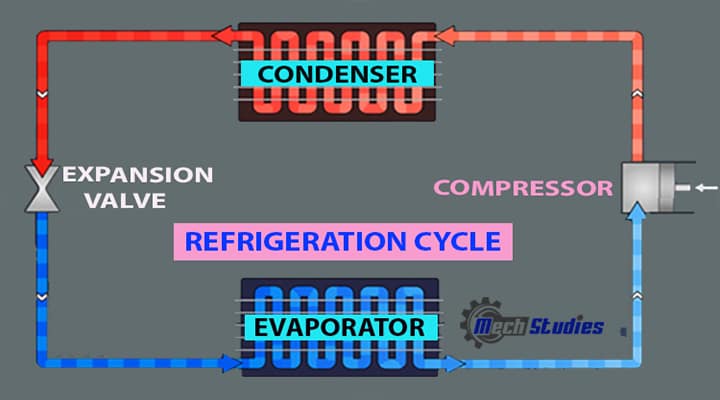
The working process is known as refrigeration cycle and it will be, as follows,
- An air conditioner operates in the same way as a refrigerator or freezer in your home, but on a wider scale.
- The distinction is that instead of absorbing heat from the edible items stored in the fridge, it absorbs heat from an entire room. The temperature is then reduced using a refrigerant.
- This chemical compound evaporates after consuming some of the room heat, and the remainder of the heat is ventilated through the exhaustion panel of the device.
- In this way, it aids you in being cozy and relaxed in the sweltering summer heat. During the cooling process, the indoor machine generates wastewater, which flows away.
- Draining water from the air conditioner suggests that the AC is functioning properly.
Check out the detailed refrigeration cycle for the basics of the working process.
Types of Room Air Conditioners
Air conditioning units are divided into three types depending on the position of compressor and blower mountings
- Window air conditioners
- Portable air conditioners
- Split air conditioners or split AC units
01. Window AC
As the name suggests, window air conditioners come in a single compact unit with a combination of compressor and blower within it. The Blower side of the air conditioner faces inside the room and the exhaust side is faced outside of the room.
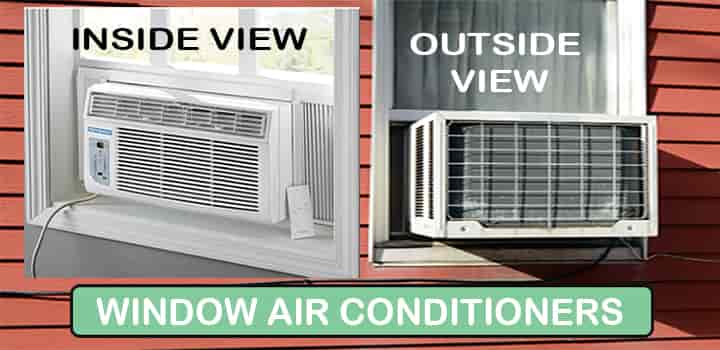
Why not choose a window air conditioning system?
- They are noisier than the other two types of air conditioners due to high vibrations.
- Even if you are planning to buy inverter type window air conditioners to avoid noise and vibrations they will cost you the same as the split type AC.
- As it is fitted in the window, the air conditioning unit is totally rigid and you can’t change its location as per your requirements. Also the position of the AC should be just that there is enough ventilation available, if not then its efficiency will decrease over time or will cost more in terms of an electric bill or it might not even last long.
- Putting a hole in the wall/window without a requirement for a window AC hole can be expensive. The structural integrity of your wall or window can also be compromised. And, of course, it will have an impact on the exterior and interior design of your room.
Nowadays technology is improved and so it is a little better than earlier window ACs. In case you have a low budget, you can buy it as well. You can explore Window Air Conditioners
02. Portable Air Conditioners
We will discuss portable air conditioners, in some other articles, however, as split AC units are widely used as room air conditioners, let’s jump into it.
03. Split AC Units
Let’s see how a split air conditioner works,
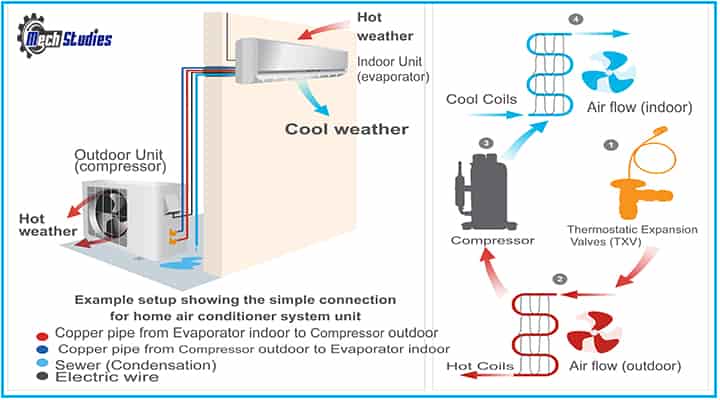
- Split air conditioning, as the term implies, is made up of two units. One device is placed outside the house (on a wall), while the other is mounted inside the house.
- The outside unit is made up of a compressor and a condenser, while the inside unit is made up of a blower, evaporator. The compressor is linked to the blower by a connecting pipe that runs through the wall. The compressor draws in air from outside and cools it before passing it to the blower. The blower blows cool air into the building.
- Split AC unit is more aesthetically appealing than most of the AC styles available, and split AC is fully capable of cooling small to large rooms as well as vast areas such as halls and industrial buildings.
- Split air conditioners can be mounted anywhere in the room. In comparison to other air conditioning systems, it is easier to use. The only thing to keep in mind is that the space in which you intend to install the Split AC must have an outside exposing wall.
Why is Split AC Better for Home Use as Opposed to Other Types?
So, what do you think about the main causes to select split air conditioners for our home? Let’s explore the concept!
- Split ACs operate at very noise with low or absolutely no vibrations. These are quieter than the inverter window AC.
- Based on the position of installation split AC can be more efficient compared to other types of air conditioning systems.
- Split AC gives you the flexibility in designing your room as it can be installed anywhere in the room as long as there are required provisions.
- Circulation of air is better than the window ACs
- Installing multiple split ACs is better for big rooms or multiple rooms without division rather than multiple window ACs or a combination of split and window ACs.
- Window ACs are required directly exposed wall so that condensing part can be exposed to the atmosphere. On the other hand, directly exposed all is not required for split AC units, as the outdoor units can be kept 10m away from the indoor unit.
- Window ACs don’t look aesthetically appealing and they’re not very effective in a cold climate, provided that walls in temperate countries are thicker and cold is more difficult to tackle than heat, so split ACs will be more efficient to keep the space more insulated.
Selection of Split Air Conditioners
Choosing the right capacity is one of the major factors for split AC selection. Let’s try to understand,
01. Basics of Selecting Split Air Conditioners
When people talk about the size of an air conditioner, that doesn’t mean the actual proportions of the device. Rather, it refers to the cooling load, which is calculated in,
- kW (kiloWatt), or
- TR (Tonnage of Refrigeration), or
- BTUs (British Thermal Units).
We will learn the relationships between these three to have a basic idea.
- 1 TR = 12,000 BTU,
- 1 kW = 3412 BTU
- 1 TR = 12,000 BTU = 1×12000/3412 kW = 3.516 kW
02. Calculation Example for Room Air Conditioners
Now, total cooling load is calculated based software called HAP (Hourly Analysis Program) or manual method which takes the heat loads for the below,
- Outdoor air
- Solar loads through glass
- Loads due to wall, windows, partitions, floor, roof
- Equipment heat loads present inside the room,
- Occupancy,
- Lighting loads, etc.
The calculation process will be discussed in a separate article. We will simply learn a thumb rule for split AC selection to understand the selection process.
Given Data: A normal accommodation room of size 4m x 3m and with a standard height (3m) and we have to find out the right split AC capacity and quantity where,
- Light = 20 watt, 2 nos.
- Equipment load (here say, 2 Computers) = 75 watt, 2 nos.
- People = 4 nos. (Sensible load = 70 watt/person, Latent heat load =60 watt/person)
Assumption: As a thumb rule, normally we consider 1 TR per 12 m2. It means 12 m2 area can be cooled by 1 TR air conditioner (general areas without any equipment)
In case of the top floor, it can be 1 TR per 9 to 10 m2. This is just an assumption.
Final Selection of Split Air Conditioners (Based on Thumb Rule)
Step#1 : Room area = 4m x 3m = 12 m2.
Now, we have learned from the thumb rule, 1 TR required against 12 m2.
Hence, Cooling load required, Q1 =12/12 = 1 TR
Step#2: Now, we have to calculate the total heat generation from the given data,
Total heat generation, Q2
= lighting load + equipment heat load (computer) + occupancy load
= 20×2 +75×2 + 4 x (70+60) watt [From Given data]
= 710 watt or 0.710 kW [as 1 kW = 1000 watt]
= 0.710/3.516 =0.202 TR [as 1 TR = 3.516 kW]
Step#3: Now, total cooling load, Q
= Q1 + Q2
= 1 + 0.202
= 1.202 TR
Step#4: This cooling load is at outside temperature say 45 deg. C (for example) is the actual temperature. Now, we have to select a split AC unit from catalogues.
Check
- What is design outside temperature (nominal) mentioned in the catalogue?
- Normally it is at 35 deg. C.
- There will be a deration if 35 deg. C design unit is used at 45 deg. C.
In this case, a deration factor to be considered to meet the technical requirements.
Step#5: Let’s consider deration factor around 10%, so the capacity shall be,
Qactual = Q x 1.1 TR
Qactual = 1.202 x 1.1 TR = 1.32 TR
Step#6: Now, split AC unit is available for,
- 1.0 TR
- 1.5 TR
- 2.0 TR
- 2.5 TR
- 2.75 TR (few manufacturers)
- 3.0 TR (few manufacturers)
So, we have to select the next higher model to 1.32 TR that is 1.5 TR (only 1 no.)
Note: This calculation is just for illustration purposes, if you want to make it actual, then it needs to be calculated in any software like HAP considering all factors.
Selection Criteria of Split Air Conditioners as Room Air Conditioners
Whenever you are going to select a room air conditioners like split air conditioners for home, the following criteria should be kept in mind,
- Choosing the right size/capacity is important!
- Environment-friendly refrigerant
- Selecting an energy-efficient air conditioner with a higher energy rating saves operating costs!
- Variable Speed Technology air conditioners
- Should you go with Inverter or Non-inverter AC?
- Brands
- Maintenance
Let’s see all these criteria to select split AC units in detail,
01. Right Capacity of Split AC
- If you select your air conditioner based on the size of the room or space the unit must cool, then you will get the highest efficiency and thus lower your operating costs in the long run.
- To choose the correct size of air conditioning device for your house, we must first calculate heat loads.
- If the selected split AC is having a lesser capacity than the requirements, then the room will not be cooled properly.
- If the selected capacity is high with respect to the requirements, then energy will be wasted and will consume higher electricity.
02. What if AC with a smaller TR or BTU is installed?
ACs with smaller TR or BTUs will run continuously to cool the room this will eventually increase your electricity bills and also there’s a lesser chance that it will be able to cool your room effectively.
03. What if you installed AC with a larger TR or BTU than required?
The bigger is not always the better! An air conditioner with a large TR or BTU will cool the room quickly which will hamper the major reason for which the AC system is used – Dehumidifying!
- Along with cooling the air another major function of the cooling system is to remove moisture (Humidity) from the air that makes us feel sticky and hot.
- If the cooling system doesn’t run long enough it won’t be able to remove the moisture from the air. Also AC units with larger BTUs than required will turn on and off frequently.
Thus before buying measure the area of the room and calculate the BTU required properly.
04. Environment-Friendly Refrigerant
Refrigerants should be environment friendly, and it should have the lowest ODP & GWP.
- R12 or R22 etc. refrigerant should not be accepted.
- R410a, R134a, R32, R407c, etc. can be used.
05. Energy efficiency and Higher Rating
- Energy Efficiency Ratio (EER) is used to measure the efficiency of air conditioners. The energy efficiency ratio is calculated simply by dividing the cooling capacity (BTU per hour) to the input power (watts).
- The higher the EER rating more efficient is the AC thus it is important to look for the star rating label on the air conditioner unit before buying.
06. Why is star rating important?
When the temperature shoots up due to a change in weather, star-rated air conditioners help you keep the room cool and also save energy!
- Energy-star certified air conditioners use 10% less energy as compared to non-star rated appliances.
- On average it uses less than $75 per year to run.
Better components and simpler guidelines are included with star-rated room air conditioners to improve sealing and ventilation throughout the appliance, reducing expenses and inconvenience caused by air leaks.
07. Variable Speed Technology air conditioners
In a conventional type of air conditioner, the compressor operates at its full capacity to cool the room and then shut off after the desired temperature is achieved.
Thus it jumps between fully on and fully off cycles when the thermostat activates.
- Air conditioning units with variable speed technology allow controlling the speed of the internal compressor motor to adjust it as per the cooling requirements continuously and not in on & off cycles.
- This helps the air conditioning unit to regulate the room temperature more effectively using variable output while saving a considerable amount of energy during service.
- Star rated room air conditioners provide additional convenience, comfort, and energy savings by allowing you to:
- Remotely operate the unit using a phone or computer
- Pre Schedule changes to temperature as per your needs
- Receive updates on the product’s energy consumption
08. Which star rating to prefer?
If you use your air conditioner for 8 to 10 hours a day for 3 to 4 months, it is recommended that you purchase at least a 3 Star certified air conditioner.
- If you want to use your air conditioner for more than 5 to 7 months, you can choose a 5-star rating unit.
- For a period of 10 to 12 months, a cooling-only or hot-and-cold inverter AC can be used.
Although air conditioners with higher star ratings are costly, they are 35% more energy efficient than the lower star rated air conditioners.
09. Inverter or Non-inverter AC
Let’s check which one to opt Inverter or Non-Inverter?
- Inverters convert the DC (Direct current) to AC (Alternating current).
- With inverter AC, they take the AC current from the main switch then convert it to DC current, and then again convert it to AC for the compressor motor.
- In conventional ACs, compressors used to switch on and off based on the cooling requirements.
- Modern ACs with inverters are more dynamic with their switching frequency. This allows you to manage the capacity of the air conditioner as per your need allowing the compressor to work in a variable manner.
- Cooling the room at the right temperature takes time in case of inverter AC due to the complexity involved. Also, inverter AC is more expensive to repair especially when the electric circuit board breaks down. You need to change the board completely and install a new one.
- Comparatively a traditional AC without an inverter doesn’t require complete change, due to lack of complex electrical components it can be repaired easily by replacing single components.
- You can replace the parts of the inverter AC as well but if the main electrical component – microcontroller needs to be replaced, the AC system won’t work.
Let’s have look the basic difference between inverter AC and non-inverter AC:
| Description | Inverter Split Air Conditioners | Non-inverter Split Air Conditioners |
| Technology | Efficient technology | Old technology |
| Compressor | Inverter compressor, which is a variable speed type | Fixed compressor |
| Life of Compressor | Long | Less with respect to inverter compressor |
| Cooling | Compressor speed varies to adjust the cooling requirements based on heat load | Compressor speed can not vary to adjust the cooling requirements based on heat load. It will be only on or off, with no control in between. |
| Time to Cool | As speed varies, it can cool the space very faster. | It takes more time than inverter split AC. |
| Stabilizer | Normally not required, if the current fluctuation is not frequent | Normally required |
| Noise | Very Less | Less |
| Efficiency | High | Comparatively less |
| Power consumption | Less | Comparatively high |
| Electric Bill | Less | Comparatively high |
| Cost | The cost is a little high around Rs. 3000/- to Rs. 5000/ with respect to non-inverter AC of the same capacity. | Comparatively less |
But here’s a bright side
The right amount of power needed will be used in Inverter type AC since its capacity is variable. Thus making inverter air conditioners more efficient and cost-effective than traditional air conditioners.
10. Brands for Split or Room Air Conditioners
There are a lot of manufacturers available in the market. Now, which one needs to be selected for your home? It is a very difficult question to answer, however, based on efficiency, review, operations, few brands are listed,
- Hitachi
- Daikin
- Mitsubishi
- Voltas
- Blue Star,
- Trane
- York
- O’ General, etc.
11. Maintenance of Split AC
This is one of the most important aspects to select split air conditioners. Split AC requires frequent maintenance, hence, whatever model you are going to select, you should check,
- Whether there is any service center
- And that should be near your vicinity
12. Guarantee
The heart of split AC is a compressor and it should be guaranteed for a minimum of 10 years.
Miscellaneous Items for Split AC Units
Filter: The filter purifies the air and is also capable of trapping particulate matter. Air conditioners mentioning the PPM statistics meant for harmful pollutants is what you should focus on and not on those catchy advertisements stating generic bacteria filters. The filter improves indoor air quality and ensures clean air.
Heating: Most air conditioners are just meant for cooling and not for heating. If you buy an air conditioning unit that can cool in summer and give warmth in winter it will save the cost of an extra appliance.
Timer: Having a timer is an important function if you want your AC to operate for a specific time. For example, if you want to run your AC before sleeping and want it to shut off automatically after some time, in such case timer will be helpful.
Advanced Features for Split AC Unit Selection
Let’s see some advanced features of split AC units,
- Wifi connectivity – Wireless accessibility to your AC even when you’re not at home for remote access.
- Self-cleaning – Automatically clean the filters and dust sitting on the cooling panel.
- Activity sensors – Automatic room monitoring to save power if you’re not in the room.
- Voice control – Voice command control for hands-free operations.
- App control – Replace traditional remotes with advanced apps to control AC and give updates regarding its operation.
Pro Tip for Split Air Conditioners
- Installing a wall-mounted built-in air conditioner rather than a window air conditioner is more reliable and has improved ventilation.
- A window air conditioning unit is installed at a lower position in the room. Wall-mounted built-in split air conditioning units are usually installed at higher positions on the wall.
- When the cool filtered air comes down from a higher point it has its own advantage for stirring the air in the room and decreasing the room’s temperature more effectively.
- The thermostat which regulates the temperature of the air conditioning system is placed within the air conditioning unit thus higher mounting is suitable.
- The flexible design of split AC helps in easy removal of the indoor unit for cleaning and maintenance purposes. It can also be packed and stored easily until the winter is gone.
- Normally in winter conditions, split AC is kept switched off and it is for a couple of months. Remember, prior to the summer season, it is always recommended to service so that it will be cleaned and no dirty air will be breathed in.
Disadvantages of Split AC Units
There are a few disadvantages of split AC units. These are as follows,
- Fresh air cannot be provided, which may cause nausea/headache
- It is not available for more than 2.5 TR or few cases 3.0 TR capacity.
- Required regular maintenance to avert water leakage problems.
- Split AC life is 12-15 years.
A Few Recommended Split Air Conditioners
Let us see a few high rated & efficient split air conditioners which you can buy for your home:
Best Choice (India)
- Daikin 1.5 Ton 5 Star Inverter Split AC

- Carrier 1.5 Ton 5 Star AI Flexicool Inverter Split AC

- Blue Star 1.5 Ton 5 Star Convertible 5 in 1 Cooling Inverter Split AC

- LG 1.5 Ton 5 Star AI+ DUAL Inverter Wi-Fi Split AC

- Voltas 1.5 Ton 5 Star, Inverter Split AC

- Samsung 1.5 Ton 5 Star Inverter Split AC

- Hitachi 1.5 Ton 5 Star ice Clean Xpandable Plus Inverter Split AC

Budgetary Choice (India)
- Carrier 1.5 Ton 3 Star AI Flexicool Inverter Split AC

- Voltas 1.5 Ton 3 Star, Inverter Split AC

- Daikin 1.5 Ton 3 Star Inverter Split AC

- Blue Star 1.5 Ton 3 Star 5 in 1 Convertible Inverter Split AC

- Panasonic 1.5 Ton 3 Star Wi-Fi Inverter Smart Split AC

- Lloyd 1.5 Ton 3 Star Inverter Split AC

- Daikin 1.5 Ton 3 Star Inverter Split AC

Conclusion
Hence, we have got a basic understanding of split AC units, as one of the best room air conditioners. Any doubt, please feel free to ask!

